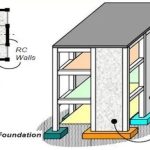The structural systems in the building are the core of the robustness of the building above the ground. This structural system serves to hold and channel the horizontal and vertical force load evenly on the core structural systems and supporting structures, so that the building can bear the horizontal and vertical load as well as lateral force.
The following are the types of core structures of the building system
- Parallel bearing walls (parallel bearing walls)
This system consists of a reinforced vessel field element with the weight of the wall itself, thus able to withstand lateral axial forces efficiently. This parallel wall system is used in apartment buildings that do not require a large free space and the mechanical systems do not require core structures.

- System core structure and supporting wall (core and bearing walls)
This system is a vertical plane that forms an outer wall and surrounds a core structure. This allows open interior space that depends on the stretch ability of the floor structure. This system includes vertical mechanical transport systems as well as increasing the rigidity of the building.

- System structure stand-alone box (self supporting boxes)
This system is a prefabricated three-dimensional unit that resembles a supporting wall building located somewhere and in combination with other units. For example, these boxes are stacked like bricks with “English Bond” patterns so they are arranged like alternating wall beams.

Cantilever plate structure system (cantilever slab)
The matting of a floor plate from a central core will allow a column free space whose limits of plate strength are the size limit of the building size. This system requires a lot of iron, especially if the projection plate is very large. The stiffness of the plate can be increased by using prestressed techniques.

Flat plate structure system (flat slab)
This system consists of a horizontal plane which is generally a thick and flat concrete floor plate that rests on a column. If there is no thickening of the plate at the top of the column, then the system is said flat plate system. In both systems there is no deep beam so the floor height can be minimum.

Interspasial system structure (interspasial)
A tall, high-altitude frame skeleton system is applied to each intermediate floor to allow for flexible space inside and on the frame. The room inside the floor frame on it can be used as a container for other activities activities.




Comments are closed